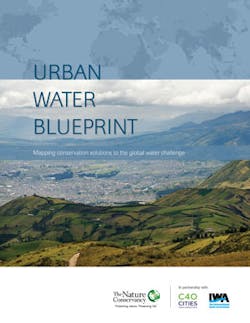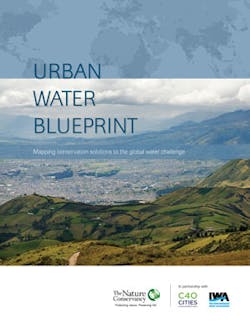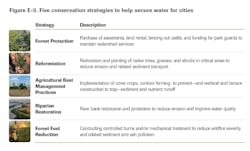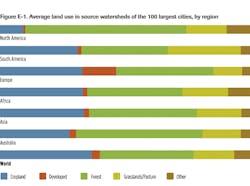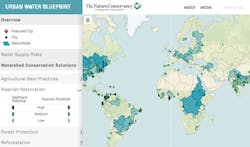Nature's Return: Investment in Watershed Conservation Yields Significant Cost-Savings for Water Utilities
By Robert McDonald and Daniel Shemie
Denver gets about half of its water supply from a complex system of reservoirs, pumps and multi-mile tunnels that transport snowmelt from the western slopes of the Rocky Mountains to the city's location just east of the range. It's a feat of modern infrastructure -- one that water professionals know well and use as a model for securing water for cities. Despite Denver's sophisticated delivery system and water efficiency and reuse measures, its water supply remains at risk.
A history of fire suppression has led to the growth of low brush and other flammable vegetation threatening the city's source water. This vegetation near Denver's water intake has the potential to escalate a naturally occurring fire into a catastrophic event. Large fires can leave behind massive amounts of ash, sediment and debris, clogging rivers and streams, and ultimately water systems and reservoirs. Consequently, water utilities end up paying the price in hefty treatment costs.
Recognizing the link between land management, catastrophic fires and water security, Denver's water utility has begun investing in the removal of forest fuel and other watershed projects totaling $33 million over five years. A partnership with the U.S. Forest Service covers half the cost, enabling the city to maximize this protection. The effort effectively saves millions of dollars in avoided treatment costs, as well as the development of alternative sources.
Watershed Conservation: The Value to Cities
While the 100 largest cities in the world occupy less than 1 percent of our planet's land area, their source watersheds cover more than 12 percent. That's an area of land roughly the size of Russia -- 17 million square kilometers -- that collects, filters and transports water to nearly a billion people before it ever enters a pipe. It's a startling reminder that not only does land far beyond city limits impact city water but that cities indeed shape the landscape around them by defining a route of development for both themselves and their neighbors.
The Urban Water Blueprint-- a new report by The Nature Conservancy in partnership with C40 Cities Climate Leadership Group and the International Water Association -- collected and analyzed three years' worth of data in more than 2,000 watersheds and 530 cities worldwide. The report reveals the annual costs -- and potential cost savings -- of watershed conservation at scale.
Denver isn't the only city that faces complex water challenges. Chances are you live or work in a region where drinking water sources are increasingly insecure. The Blueprint finds that one in three of the largest 100 cities worldwide is currently water stressed, and their water sources are often polluted, with hundreds of millions of city dwellers relying on water from low-quality sources.
The availability and quality of city water supplies, and the costs to move and treat them, depend heavily on how land in source watersheds is used. This fact is already widely understood, but what has been less clear is how much land management strategies can improve water quality. The Blueprint evaluates five proven strategies from forest fuel management to stream bank restoration and improved farming practices (see Fig. 1).
The report reveals that there is no silver bullet conservation strategy when you consider the variation of land use across regions. So while the average source watershed globally is covered by 40 percent forest, 30 percent cropland and 20 percent grassland and pasture, the majority of North America's cities draw water from sources that have a much higher percentage of forest. That said, a city located in the midwestern United States may have more in common with cities in Asia, where watersheds have a higher percentage of agriculture (see Fig. 2).
The Urban Water Blueprint explores how these different conservation strategies can reduce phosphorus, nitrogen and sediment pollution while yielding other benefits. For instance, 247 of the 550 cities could see a measurable reduction in nutrient loading -- up to a 10 percent reduction in phosphorus -- by applying reforestation efforts to a specific area.
A case study near São Paulo, Brazil, illustrates this point. While trees won't make it rain in this drought-stricken city, they can dramatically reduce the amount of sediment loading entering the Cantareira water system by minimizing erosion. Less sediment in the source means less wastewater is generated at the treatment plant. It is a fact that can't be ignored when every cubic meter counts, and when you consider the high costs of water treatment and sludge disposal.The Blueprint suggests that restoring just 14,200 hectares of deforested areas and preventing erosion on just over 2,000 hectares in São Paulo's watershed can cut the concentration of sediment in half. As part of Brazil's first Water Producer Program, farmers and ranchers in the nearby municipality of Extrema are paid US $120 per hectare to reforest or terrace their fields, among other strategies. This has led to improved water quality for the city and also benefits farmers and ranchers.
The Return on Investment for Water Utilities
Sourcing information on reported water treatment plant operations and maintenance (O&M) costs from a sample of cities, the Urban Water Blueprint shows that reductions in sediment and nutrients by 10 percent leads on average to a roughly five percent reduction in treatment costs. If all possible conservation strategies were applied, global water savings on treatment plant O&M would be US $890 million per year.
Out of all 534 cities analyzed, one in four would realize a positive return on investment after implementing watershed conservation measures. The report estimates that 59 cities in the U.S. alone fall into this category, including Los Angeles, Portland, Ore., and Atlanta. Of course, the return on investment would vary widely among cities.
A well-known case study in New York City offers testimony to this return. In the 1990s the city needed to demonstrate to state and federal regulators that it could comply with the federal Safe Drinking Water Act. Officials discovered that building an additional water treatment plant would cost approximately $8-10 billion dollars, not including hundreds of millions in annual O&M. In contrast, they found they could meet the federal standards by protecting the city's water source instead. Now, New York City is investing $1.5 billion over 10 years to preserve its forested watershed, acquire new land and restore critical habitats -- ultimately keeping the water supply among the cleanest in the world.
Cities that embrace this strategy will recognize multiple benefits. In addition to improving water quality, source watershed conservation improves aquatic and terrestrial biodiversity. The strategies can also generate jobs in rural communities and recreational benefits for all to enjoy. These benefits are not as easily monetized but they offer untapped political capital to mayors and utility managers willing to do things differently.
The Blueprint as a Decision-Making Tool
The Urban Water Blueprint provides a resource for decision-makers in evaluating water quantity and quality risk across the world's largest cities, the steps cities have taken to overcome stress, and the cost benefits of incorporating natural solutions into their water management plans. Likewise, it outlines recommendations for cities, water utilities and partners interested in realizing the market potential of natural solutions. By laying out elements of a scale-up approach, the Blueprint provides cities with a recommended pathway for successfully implementing conservation measures, monetizing the value of watershed conservation and stimulating demand for additional natural infrastructure.
In addition to the report, The Nature Conservancy produced a corresponding interactive website (nature.org/waterblueprint; see Fig. 3) that translates the data into layered maps and scenarios. All 534 cities analyzed are featured on the website, and users can find detailed information on the water quantity and quality of that city and relevant conservation solutions that could be applied to the watershed to improve water quality. While not a substitute for local data and expertise, the website can help serve as a rapid assessment tool for those interested in understanding the water risks and opportunities in their city.
About the Authors: Rob McDonald is a senior scientist for urban sustainability at The Nature Conservancy. He researches the impact and dependence of cities on the natural world, and is the lead scientist for much of the Conservancy's urban conservation work. Daniel Shemie serves as director of Water Funds within The Nature Conservancy's Global Water team. In this role, he manages the overarching strategies of accelerating the use and financing of natural infrastructure in urban water supply.
